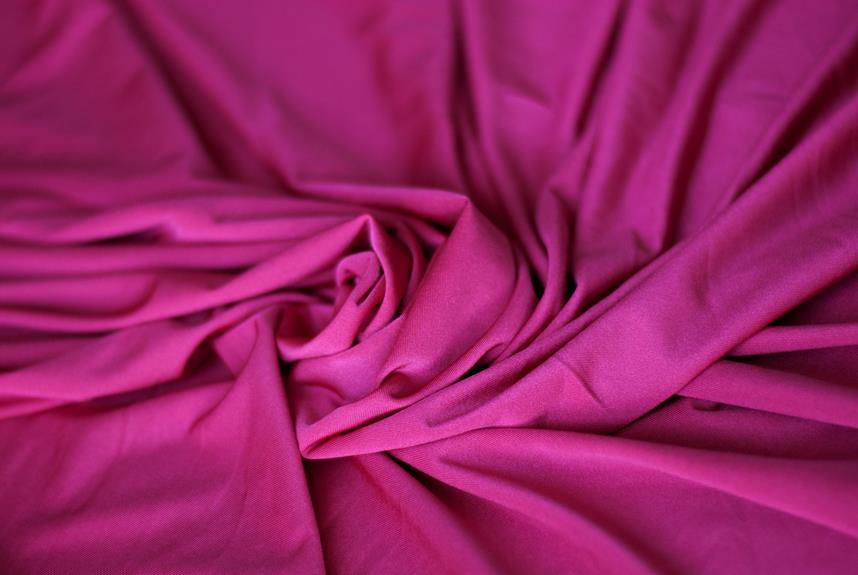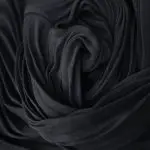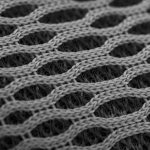When you're choosing between voile and chambray, it's essential to consider what each fabric offers. Voile, known for its lightweight and sheer qualities, works wonders for those breezy summer days, while chambray's sturdiness brings a casual yet structured vibe to your wardrobe. Both have unique textures and care requirements that can affect your clothing projects. So, how do you decide which one suits your needs best? Understanding the key differences and common uses can guide you in making the right choice for your next project. Let's explore these fabrics further.
Table of Contents
What Is Voile?
Voile is a lightweight, sheer fabric that's perfect for adding a delicate touch to your wardrobe. Made from cotton, polyester, or a blend of both, it's known for its soft texture and elegant drape. When you wear voile, you'll notice how it gracefully flows, making it ideal for summer dresses, blouses, and lightweight curtains.
One of the best things about voile is its breathability. You can stay cool and comfortable even on the hottest days. Plus, it's easy to care for; most voile fabrics are machine washable, which means you won't have to worry about extensive upkeep.
In terms of design, voile comes in a variety of colors and patterns, allowing you to express your style effortlessly. Whether you prefer floral prints or solid hues, you'll find something that fits your aesthetic.
When layering, voile adds an ethereal feel without adding bulk. You can pair it with heavier fabrics for contrast or let it stand alone for a light, airy look. Overall, voile is a versatile fabric that enhances your wardrobe and keeps you looking chic.
What Is Chambray?
Chambray is a versatile fabric with a rich history that's worth exploring.
You'll notice it's woven differently than other materials, giving it a distinct texture that sets it apart.
Plus, understanding its common uses can help you choose the right fabric for your next project.
Origin of Chambray Fabric
Originating in the early 19th century, chambray is a lightweight cotton fabric known for its distinctive woven appearance and vibrant color. This fabric traces its roots back to a French village called Cambrai, where it was initially produced. The name 'chambray' is derived from this locale, reflecting its heritage.
You'll find that chambray became popular due to its versatility and comfort. Originally, it was often used for shirts and dresses, gaining traction among workers and farmers for its practicality. Over time, it transitioned into mainstream fashion, appealing to both casual and formal wear enthusiasts.
Historically, chambray fabrics were made using dyed warp threads, while the weft threads remained undyed, creating a unique interplay of colors. This technique, along with its soft texture, made chambray a go-to option for many clothing items, from shirts to skirts.
Today, you can spot chambray in various styles, including denim-like finishes and lighter, airy versions suitable for warm weather. Its rich history and adaptability continue to make chambray a staple in contemporary wardrobes, ensuring it remains a beloved fabric choice.
Weave and Texture Differences
When comparing chambray to other fabrics, its unique weave and soft texture stand out, making it a favorite for both casual and stylish attire. Chambray features a characteristic plain weave, where colored threads are woven with white threads, creating a subtle, denim-like appearance. This distinctive blend gives chambray its signature look while maintaining a lightweight feel that's perfect for layering.
The texture of chambray is smooth and soft against your skin, ensuring comfort throughout the day. Unlike heavier denim, chambray's lightweight nature makes it breathable, making it suitable for warmer weather. You'll appreciate how easily it drapes, lending a relaxed vibe to any outfit.
In contrast, voile has a much lighter, more sheer quality due to its loose weave, which gives it a delicate, airy feel. While both fabrics have their charm, chambray's slightly heavier texture contributes to a more structured silhouette.
Common Uses and Applications
This versatile fabric is often used to create everything from casual shirts and dresses to stylish accessories, making it a staple in many wardrobes. Chambray's lightweight, soft texture and breathable nature make it perfect for various applications, especially during warmer months. You'll find it's a go-to choice for both everyday wear and more polished looks.
Here are some common uses for chambray:
- Casual Shirts: Ideal for relaxed, laid-back outfits.
- Dresses: Flattering and comfortable, perfect for day outings.
- Skirts and Shorts: Great for a breezy, chic summer look.
Whether you're dressing up for a casual brunch or keeping it simple for a day out, chambray's versatility shines through. Its ability to easily pair with other fabrics and colors means you can create endless outfit options.
Key Differences Between Voile and Chambray
When choosing between voile and chambray, you'll notice some key differences that set them apart.
Their fabric compositions vary, affecting both weight and texture.
Understanding these distinctions can help you make the right choice for your next project.
Fabric Composition Variations
Voile and chambray differ significantly in their fabric compositions, affecting their texture, drape, and overall appearance. Understanding these variations helps you choose the right fabric for your projects.
Voile is typically made from lightweight cotton, though it can also contain silk or polyester blends. This gives it a soft, sheer quality that flows beautifully. The lighter composition of voile makes it an excellent choice for airy garments, like summer dresses or blouses. Additionally, voile's sheerness allows for layering.
Chambray, on the other hand, is woven from dyed warp threads and white weft threads, usually using cotton. This results in a more durable fabric with a slight texture that resembles denim. Chambray's sturdiness lends itself well to shirts and casual wear, while its opacity makes it suitable for standalone pieces.
Weight and Texture Differences
Understanding the fabric composition sets the stage for recognizing the key differences in weight and texture between voile and chambray.
Voile is a lightweight, sheer fabric typically made from cotton or a cotton blend, giving it a delicate, airy feel. When you wear or handle it, you'll notice how it drapes softly, making it perfect for flowing dresses and curtains.
On the other hand, chambray is a medium-weight fabric that mimics denim but is lighter and softer. It's usually woven with a colored yarn in the warp and white yarn in the weft, resulting in a subtle texture that feels more structured than voile.
When you touch chambray, you'll feel its smoothness and slight heft, which lends itself well to shirts and casual wear.
Common Uses for Voile
You'll often find voile in lightweight curtains, summer dresses, and delicate blouses, thanks to its airy feel and elegant drape. This versatile fabric is perfect for a variety of applications, making it a popular choice among designers and DIY enthusiasts alike.
Here are some common uses for voile:
- Curtains: Its sheer nature allows soft light to filter through while providing a touch of privacy.
- Dresses: Voile's lightweight quality makes it ideal for creating flowing summer dresses that keep you cool.
- Blouses: The soft drape of voile adds a feminine touch to blouses, making them perfect for casual or formal occasions.
Whether you're sewing a new outfit or decorating your home, voile's delicate nature and breathable quality make it a top choice.
Its ability to blend well with other fabrics allows you to get creative, whether you're crafting something unique or simply looking to enhance your existing wardrobe.
You'll love how it elevates your style!
Common Uses for Chambray
Chambray is often favored for its versatility, making it a popular choice for a range of garments and accessories. You'll find this fabric commonly used in casual shirts and blouses, as it provides that laid-back yet polished look. It's lightweight and breathable, perfect for warm weather, so you can stay comfortable while looking stylish.
You might also spot chambray in dresses and skirts, which can easily transition from day to night. Pair a chambray dress with sandals for a casual outing, or dress it up with heels and accessories for a night out. Additionally, chambray is often used for children's clothing, as it's durable and easy to care for, making it ideal for active little ones.
Don't forget about accessories! Chambray's unique texture makes it a fantastic choice for bags, hats, and even lightweight scarves. You can mix and match chambray with other fabrics, adding a touch of casual elegance to your outfits.
Whether you're aiming for a classic denim look or something more refined, chambray offers options that fit seamlessly into your wardrobe.
Care Instructions for Both Fabrics
When caring for both chambray and voile, it's important to follow specific washing and drying instructions to maintain their quality and appearance. Each fabric has its nuances, so being mindful will prolong their lifespan and keep them looking fresh.
Here are some essential care tips for both fabrics:
- Washing: Use cold water and a gentle cycle. Hot water can cause chambray to fade and voile to shrink.
- Detergent: Opt for a mild detergent to avoid damaging the fibers. Avoid bleach, as it can weaken the fabric.
- Drying: Air-dry both fabrics whenever possible. If you must use a dryer, choose a low heat setting to prevent shrinkage.
Frequently Asked Questions
Can Voile and Chambray Be Blended With Other Fabrics?
Yes, you can blend voile and chambray with various fabrics. Mixing them with cotton or linen creates unique textures and styles, enhancing drape and breathability. Experimenting will help you discover beautiful combinations for your projects.
What Are the Best Seasons to Wear Voile and Chambray?
You'll love wearing voile in spring and summer for its lightness and breathability. Chambray shines in warmer months too, but it's versatile enough for early fall, pairing nicely with layers as temperatures cool down.
Are There Any Eco-Friendly Options for Voile and Chambray?
You'll find eco-friendly options for both fabrics, like organic cotton or recycled fibers. Look for certifications like GOTS or OEKO-TEX, which ensure sustainable practices. Choosing these materials can help reduce your environmental impact significantly.
How Do I Identify Authentic Voile and Chambray Fabrics?
To identify authentic voile and chambray, check the texture and weave. Voile's lightweight and sheer, while chambray feels sturdier with a slight sheen. Also, examine the fabric's drape and look for consistent patterns.
What Are the Price Ranges for Voile and Chambray Fabrics?
When you're shopping for fabrics, you'll find voile typically ranges from $5 to $15 per yard, while chambray usually costs between $7 and $20 per yard. Prices can vary based on quality and design.
- The Use of Nonwovens in Construction and Civil Engineering - July 11, 2025
- The Use of Nonwovens in Construction and Civil Engineering - July 11, 2025
- The Use of Nonwovens in Construction and Civil Engineering - July 11, 2025







